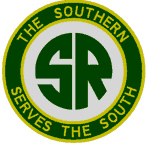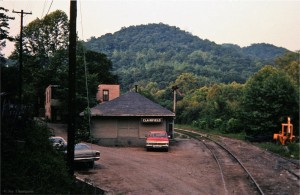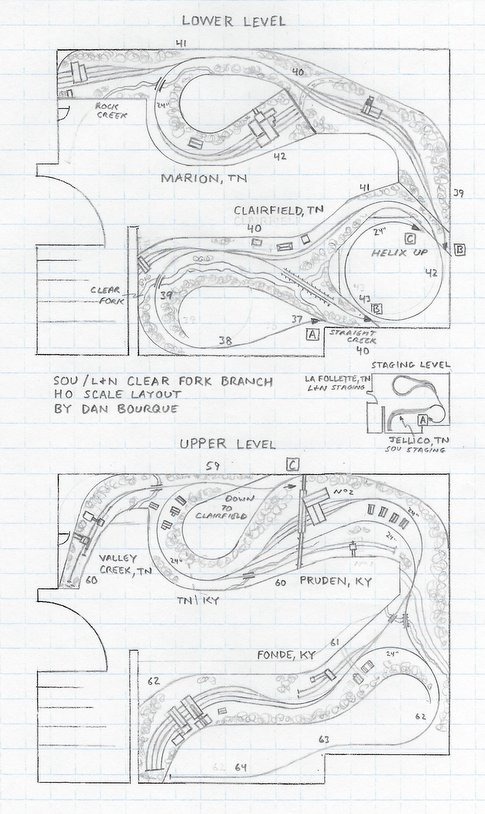- Size: 12′ x 16 ′
- Scale: HO
- Minimum Radius: 24″
- Minimum Aisle Width: 30″
- Designed by Dan Bourque
 The Clear Fork Branch on the border of Tennessee and Kentucky branched from the L&N’s mainline but was owned by the Southern Railway and jointly served by both roads. The Southern reached it via trackage rights from a connection to it’s Jellico line a couple miles north of the branch. The branch was several miles long, but most of the loaders were stacked in the last half of the branch between Clairfield, TN and Fonde, KY.
The Clear Fork Branch on the border of Tennessee and Kentucky branched from the L&N’s mainline but was owned by the Southern Railway and jointly served by both roads. The Southern reached it via trackage rights from a connection to it’s Jellico line a couple miles north of the branch. The branch was several miles long, but most of the loaders were stacked in the last half of the branch between Clairfield, TN and Fonde, KY.
The Layout
This track plan captures the Clear Fork Branch from Clairfield to Fonde and also includes the smaller branch from Clairfield up Straight Creek. The loaders changed significantly over the years, so this particular plan represents the early diesel era up until the ’60s when Southern F-units and L&N RS3s dominated the mine runs. It’s designed to fit into the back room of a basement, hence the unusual door arrangement and room shape. This plan packs as much operation as possible into the space, so it’s double-decked, and the biggest compromises are a tight 24″ minimum radius and lots of stub tracks where double-ended arrangements existed on the prototype.
The lower deck represents the Tennessee portion of the line around Clairfield and the branch up Straight Creek to Marion along with its three good-sized tipples. The upper deck represents the Kentucky end of the line and includes all the loaders from Valley Creek, Pruden and Fonde albeit in compressed format. Stub tracks save space but require extra run-arounds. On the lower deck, I added a siding adjacent to the loader between Clairfield and Marion to turn cars prior to shoving them to the tipples. On the upper deck, I extended the tail track of the wye to allow entire trains to turn around before serving the stub tracks at Fonde or Valley Creek.
The staging level is reached via a couple turns in the helix and is split into two halves, a 3-4 track stub yard representing Jellico, TN, the Southern’s mine-run origin point. The L&N’s staging yard is a 2-3 track reversing loop representing LaFollette, TN. Each staging yard can hold trains of 2-3 locomotives, 16-20 cars and a cab. There are a lot of tracks shoved into this space, so a larger DCC system with walk-around throttles is recommended.
Operations
 Operations on this layout would keep 1-2 operators for 2-3 hours. According to a 1976 timetable, this area was served at least once a day by both the Southern and L&N, but the additional loaders in the 1950s and 60s would easily support a third mine run. Per the timetable, the Southern’s mine run, train 201, arrived on the line at 5:30 AM and arrived at Clairfield at 6:01 AM. It worked the tipples past Clairfield until 8:15 AM when it became train 202 and headed back toward Jellico. The L&N’s mine run, train 145, arrived at Clairfield at 3:30 PM and worked the mines until 5:00 PM when it headed back toward LaFollette as train 144. In the ’60s, with more loaders active, these times could be extended, or a third mine run could be added. Typical power for the Southern mine runs would be 2-3 F-units with an occasional GP7, and the L&N mine runs would be dominated by RS3s in various color schemes.
Operations on this layout would keep 1-2 operators for 2-3 hours. According to a 1976 timetable, this area was served at least once a day by both the Southern and L&N, but the additional loaders in the 1950s and 60s would easily support a third mine run. Per the timetable, the Southern’s mine run, train 201, arrived on the line at 5:30 AM and arrived at Clairfield at 6:01 AM. It worked the tipples past Clairfield until 8:15 AM when it became train 202 and headed back toward Jellico. The L&N’s mine run, train 145, arrived at Clairfield at 3:30 PM and worked the mines until 5:00 PM when it headed back toward LaFollette as train 144. In the ’60s, with more loaders active, these times could be extended, or a third mine run could be added. Typical power for the Southern mine runs would be 2-3 F-units with an occasional GP7, and the L&N mine runs would be dominated by RS3s in various color schemes.
Before each operating session, the tipples would need to be divided between Southern and L&N based on the cars at the tipple, and instructions would be given to the mine run crews on which tipples to work. In this way, each operating session can be different from the last based on which tipples are operating, which are idle, and which railroad each is loading for. In the era of single car loadings (including the ’50s and ’60s), it’s also likely a few of the tipples would have loaded cars for both the Southern and L&N in the same day. Working the tipples would be challenging because of the many stub tracks. There are sufficient run-arounds (including the wye at Fonde) to assist, but there would still be a lot of moves required. For this reason, two-person crews (one engineer and one conductor/brakeman) would work well on this layout.
Things I Like About this Plan:
- Lots of switching
- Lots of operation for the space
- Two railroads
Things I Don’t Like About this Plan:
- Tight radii
- Significant compression
- Lots of curved switches
- Some tough-to-reach tracks
- No continuous running
- No non-coal traffic
Related Products:






This was a very interesting branch. Around 1900 both L&N and SR were fighting over access to the area, and a judge “split the baby” by giving the west end (to the tunnels) to L&N and the east end to Fondee (Starting at MP62 I believe) to SR. But SR was stuck with maintaining the L&N/CSXT end (L&N had little or no business then) until I terminated the agreement and made CSXT do their own maintenance. I remember the Clairfield depot in service then (early 80’s). My congratulations on modeling this ignored branch.
Thanks for posting! I hope someday someone will model this great portion of railroad (unfortunately I don’t know anyone who does), but for now it’s just an idea.